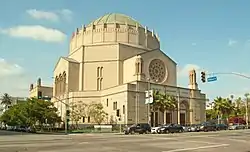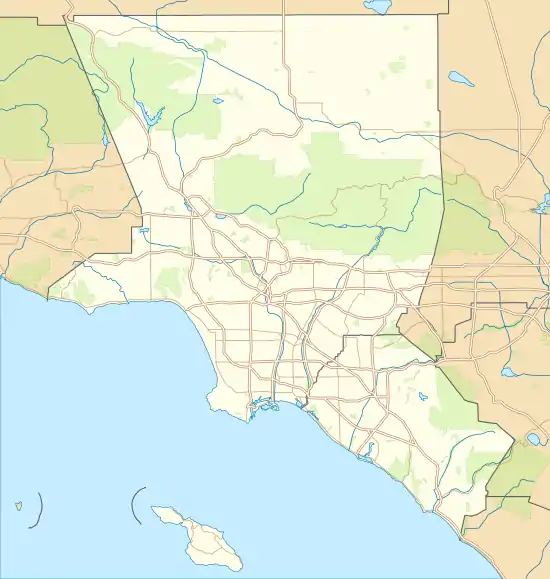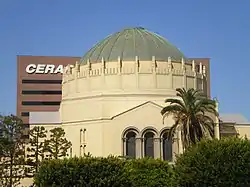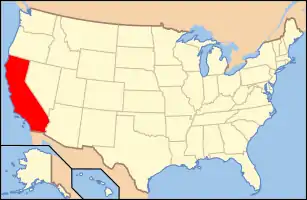Wilshire Boulevard Temple
Wilshire Boulevard Temple, known from 1862 to 1933 as Congregation B'nai B'rith, is the oldest Jewish congregation in Los Angeles, California.[3][4] Wilshire Boulevard Temple's main building, its sanctuary topped by a large Byzantine revival dome and decorated with interior murals, is a City of Los Angeles Historic Cultural Monument and is listed on the National Register of Historic Places.[1][3][5][6][7] The Moorish-style building, located on Wilshire Boulevard in the Wilshire Center district, was completed in 1929 and was designed by architect Abram M. Edelman (son of the congregation's first rabbi, Abraham Edelman).
Congregation B'nai B'rith | |
 Wilshire Boulevard Temple | |
   | |
| Location | 3663 Wilshire Blvd., Los Angeles, California |
|---|---|
| Coordinates | 34°3′44″N 118°18′17″W |
| Built | 1928 |
| Architect | Edelman, A.M.; Norton, S. Tilden |
| Architectural style | Byzantine Revival |
| NRHP reference No. | 81000154 |
| LAHCM No. | 116 |
| Significant dates | |
| Added to NRHP | 21 December 1981[1] |
| Designated LAHCM | March 21, 1973[2] |
Wilshire Boulevard Temple is one of the largest Jewish congregations in Los Angeles, and has been led by several influential rabbis, especially Edgar Magnin, who has been described as the "John Wayne" of rabbis[8] and who served for 69 years from 1915 to 1984. A second campus, on the Westside, opened in 1998. Despite repeated reports that the congregation might sell its older, landmark building in the changing Koreatown neighborhood, the temple began extensive renovations of the historic facility in 2008 under the leadership of the Senior Rabbi, Steven Z. Leder.[9] The remodeled sanctuary reopened in 2013. In 2018, construction began on the Audrey Irmas Pavilion, a major expansion on the original site.[10]
History
Early years
Wilshire Boulevard Temple traces its origins to the first Jewish worship service in Los Angeles, held in 1851. In 1862, a small community of Los Angeles Jews received its charter from the state to found Congregation B’nai B’rith. Worship was led by a layman, Joseph Newmark, until Abraham Wolf Edelman was hired as the first rabbi.[11] Long overshadowed by the more prosperous San Francisco Jewish community, L.A.'s Jews managed to erect the congregation's first building, an impressive brick Gothic Revival style synagogue built in 1873 at the corner of Temple and Broadway in downtown Los Angeles.[12] It was described by the Los Angeles Star as “the most superior church edifice in Southern California.”[3]
%252C_located_on_Hope_and_9th_Streets%252C_Los_Angeles%252C_ca.1900_(CHS-5118).jpg.webp)
By 1885 much of the congregation was pushing to move away from Orthodox practice, and Rabbi Edelman eventually resigned. Ephraim Schreiber was hired as rabbi in 1885 and adopted some reforms, but soon left. Abraham Blum was hired in 1889, but was forced out in 1895 and replaced by Moses G. Solomon.[11]
In 1896, the B'nai B'rith congregation moved to a larger brick Victorian synagogue at 9th and Hope. It was also designed by A.M. Edelman, and had tall flanking towers capped with large onion domes.
Sigmund Hecht became rabbi in 1899, and in 1903 the congregation joined the Union of American Hebrew Congregations, the national organization of the Reform movement. Edgar Magnin was hired as an assistant rabbi in 1915, and took over as senior rabbi upon Hecht's retirement in 1919. Both Hecht and Magnin implemented the Reform practice of the time, including heavier use of the English language and organ and choir music.[11]
Rabbi Magnin and the move to Wilshire Boulevard
The current Wilshire Boulevard Temple opened in 1929, built among other significant places of worship in the Wilshire Center area. The new temple was the dream of Rabbi Edgar Magnin who, over a career of seven decades, forged a Jewish identity for Los Angeles that joined pioneers and Hollywood moguls. Known as the "Rabbi to the stars",[8] Magnin came to B'nai B'rith as assistant rabbi in 1915 and from that time on he championed a new synagogue building. The involvement of the Hollywood moviemakers after World War I and Magnin's promotion to senior rabbi in 1919 allowed the building to go forward. Mostly displaced New Yorkers with marginal religious interest, the Hollywood producers were attracted to Magnin's image of a popular modern Judaism. Rabbi Magnin also foresaw the movement of the city, and especially its Jewish population, westward. In this, the Wilshire Boulevard Temple was both typical and prescient in anticipating the increased suburbanization of American Jewish life. Because the new synagogue was beyond the "car line," it presaged L.A.'s near-total dependence on the automobile, an urban-suburban transformation that would affect most Jewish communities only after World War II.[12]
The artistic highlights of the temple include the Biblically-themed Warner Memorial Murals, painted by Hugo Ballin and commissioned by the Warner Brothers (who founded the movie studio of the same name), Jack, Harry, and Albert.[3][5][13][14] Ballin's murals consist of 320-foot-long (98 m), 7-foot-tall (2.1 m) murals depicting key moments in Jewish history.[3][5] The murals are atypical of Judaism's traditional avoidance of figurative synagogue art.[15] In deciding to include murals in the new temple, Magnin was inspired by his recent visits to great European cathedrals; the particular role of Los Angeles as the capital of the movie industry; and archaeological discoveries of the time that suggested that ancient synagogues used figurative art.[16]
Modeled after Rome's Pantheon, the immense Byzantine revival dome stands at 100 feet (30 m) in diameter with its top 135 feet (41 m) from the street.[8] Its base is flanked by 28 buttresses, or small towers, rising from the ring girder for support. Funding for the dome's interior decoration was donated by MGM studio production head Irving Thalberg. The prayer inscribed in Hebrew around the Oculus, at the apex of the interior coffered dome, comes from the shm'a prayer, a centerpiece of all Jewish prayer services. The words read: Shm'a Yisroael, Adonoi Eloheinu, Adonaoi Echad; which translates to "Hear, O Israel, the Lord our God, the Lord is One."
Designed in the Gothic tradition by the Oliver Smith Studios of Pennsylvania, the Temple's distinctive rose window on the south wall of the sanctuary, and stained glass windows on the east and west walls, have been described as being among the finest examples of this art form in the United States. During the recent renovation, the rose window was removed and repaired at the Judson Studios in Los Angeles. The Rose Window depicts a Torah Scroll and a Star of David in the center and symbols of the Twelve Tribes of Israel in the outer circle. The triple lancet windows on the east and west walls are each made up of some 5,000-6,000 pieces of glass and are the symbolic representation of the 12 tribes of Israel. Funding for the east and west lancet windows was donated by film producer and studio head Louis B. Mayer.

The Temple's immense dome immediately became a landmark in Wilshire Center and throughout Los Angeles. Its imposing marble columns were also a form of Hollywood magic: they are hollow columns of plaster painted to mimic marble. And unlike many synagogues, the temple has no center aisle, in part because the temple builders' wanted it to mimic a movie theater.[8]
The construction of the temple was completed by the Herbert M. Baruch Corporation and cost $1.5 million in 1929 dollars. It was dedicated in a three-day celebration in June 1929 presided over by Rabbi Magnin.
The congregation adopted its present name, Wilshire Boulevard Temple, in 1933. Magnin went on to head the temple until his death in 1984,[11] during which time he was widely considered as a spokesman on community and religious matters.[17] The block of Wilshire Boulevard where the temple sits was named Edgar F. Magnin Square in 1980 by the City of Los Angeles. In 1984, the Temple building was placed on the National Register of Historic Places.
Rabbi Fields and the Westside campus
One year after Rabbi Magnin's death, Harvey Fields became senior rabbi and led the congregation for 18 years. He reinstituted some more traditional ritual practices that had not been used under Magnin. The use of music was increased and the temple hired its first trained cantor. Fields was also founding chair of the Interfaith Coalition to Heal L.A. and "Hands Across L.A.", interfaith responses to the 1992 Los Angeles riots.[18]
In response to membership growth on the Westside of Los Angeles, the temple built a second campus at Olympic Boulevard and Barrington Avenue in West Los Angeles. It opened in 1998 as the Audrey and Sydney Irmas Campus, with a new Jewish day school and other educational and community facilities.[19] Despite repeated reports that the temple would leave its historic building, Rabbi Fields restated the congregation's commitment to the location.[20]
Over the years the temple has hosted many notable speakers, dignitaries and singers including the Dalai Lama, who received the Bodhi Award and addressed the American Buddhist Congress at the Wilshire Boulevard Temple in 1999.[21]
Rabbi Leder and the main building
In July 2000, the J. Paul Getty Trust awarded a "Preserve L.A." grant to the temple as part of its effort to preserve the city's cultural heritage.[22]
Rabbi Fields retired in 2003 and was succeeded by Steven Leder, who has served the temple's congregation since 1987.[23] In 2004, the congregation celebrated the 75th anniversary of the historic structure on Wilshire Boulevard. As the area surrounding its historic building changed dramatically (becoming part of the rapidly expanding Koreatown district), the temple faced the decision whether to sell the property and refocus its operations on the Westside, where most of Los Angeles' Jewish population had moved. Instead, because of a desire to maintain its landmark facilities and commit to its surrounding community, and also noting a trend for younger Jews to move into neighborhoods further east (such as Los Feliz and Silver Lake), the congregation decided to begin a major restoration of the sanctuary and redevelopment of the surrounding city block.[24] The renovations began in 2008 under the leadership of the Senior Rabbi, Steven Z. Leder.[25] The temple began working with architect Brenda Levin in 2005, developing an expansive master plan for what was envisioned as a campus, including a renovated synagogue, a new pre-school and elementary school, the Karsh Social Service Center, athletic and community facilities.[26] The renovation is documented in great detail in the film Restoring Tomorrow, directed by Aaron Wolf who is also a member of the temple and grandson to the late Alfred Wolf.[27]
After the end of the 2011 High Holy Days, the auditorium was closed for a renovation project that lasted two years.[28][29] In 2013, philanthropist Erika Glazer pledged $30 million through 2028 for ongoing restoration and redevelopment of the synagogue,[30] and the Wilshire Center facility is now called the Erika J. Glazer Family Campus. The sanctuary reopened in September 2013 for Rosh Hashanah services, as the temple stated its intentions to provide services for the non-Jewish, mainly Korean and Hispanic residents of the area, as well for the Jewish community.[24][31] The community outreach has been recognized by local leaders, who hope it will become a model for other organizations as well.
In 2009 the temple and its rabbi, Steven Leder, became participants in the Rabbinic Vision Initiative (RVI), a group of rabbis from large Reform congregations who became vocal critics of the Reform movement's central organization, the Union for Reform Judaism (URJ). In 2011, Wilshire Boulevard Temple resigned from the URJ in what was perceived as a protest of the organization's perceived ineffectiveness.[32]
In 2015, more than a dozen architectural firms were considered for the Audrey Irmas Pavilion by a committee made up of congregation members, including philanthropists Glazer, Bruce Karatz, Eli Broad and Anthony Pritzker. After four firms submitted detailed proposals, Rem Koolhaas and Shohei Shigematsu of the Office for Metropolitan Architecture were recommended for the $75 million structure; OMA had proposed a trapezoidal five-story building including a rooftop garden, office spaces and a large, vaulted ground-level banquet hall to replace a parking lot next to the main building on Wilshire Boulevard.[33][34][10][35]
Senior Rabbis
- Abram Wolf Edelman, 1862 – 1885
- Ephraim Schreiber, 1885 – 1889
- Abraham Blum, 1889 – 1895
- Moses G. Solomon, 1895 – 1899
- Sigmund Hecht, 1899 – 1919
- Edgar F. Magnin, 1919 – 1984
- Alfred Wolf, 1984 – 1985
- Harvey J. Fields, 1985 – 2003
- Steve Leder, 1987 – present
Notable members
- Lawrence Bender
- Lowell Ganz
- Jami Gertz
- Maurice Kremer[36]
- Tony Ressler
- Robert B. Sherman
- Fred Sands
- Daniel Steres (born 1990), professional soccer player with the LA Galaxy
- Jack L. Warner
- Bud Yorkin
See also
- List of Registered Historic Places in Los Angeles
References
- "National Register Information System". National Register of Historic Places. National Park Service. January 23, 2007.
- Los Angeles Department of City Planning (2007-09-07). "Historic - Cultural Monuments (HCM) Listing: City Declared Monuments" (PDF). City of Los Angeles. Retrieved 2008-05-28. Cite journal requires
|journal=(help) - "Our History". Wilshire Boulevard Temple.
- "Wilshire Boulevard Temple". Larchmont Chronicle.
- "No. 116: Wilshire Boulevard Temple". Big Orange Landmarks. 2008-02-22.
- "Wilshire Boulevard Temple". Levin & Associates Architects.
- Betsy Sheldon (1999). The Jewish Travel Guide, p. 92. Hunter Publishing. ISBN 978-1556508790.
- "Best Seat In The House Of Worship: The Temple Hollywood Built". NPR.org. Retrieved 2016-08-10.
- https://www.wbtla.org/pages/the-temple-pages/our-clergy/
- ZEIGER, MIMI (November 20, 2018). "Rem Koolhaas' upcoming Wilshire Boulevard Temple expansion will balance openness with security". Los Angeles Times. Retrieved 25 November 2018.
- Kerry M. Olitzky & Marc Lee Raphael, The American Synagogue: A Historical Dictionary and Sourcebook (Greenwood Press, 1996), ISBN 978-0-313-28856-2, pp. 50-52. Excerpts available at Google Books.
- American Synagogues. Gruber, Samuel. Rizzoli, New York.
- "Warner Memorial Murals". grconnect.com.
- "Wilshire Boulevard Temple - structure record". ArchitectDB.
- Laden, Tanja M. (2012-03-07). "Wilshire Boulevard Temple's Revolutionary Murals Get a Facelift". The Jewish Journal of Greater Los Angeles. Retrieved 2017-05-09 – via L.A. Weekly.
- Examples of such discoveries were Beth Alpha and Dura-Europos synagogue. See "Mural History", Journey Through the Wilshire Boulevard Temple Murals, Wilshire Boulevard Temple, 2013.
- Gary Libman, "Synagogue Looks Back on 125 Years" Los Angeles Times, December 17, 1987.
- Elaine Woo, "Harvey J. Fields dies at 78; rabbi led Wilshire Boulevard Temple", Los Angeles Times, January 24, 2014.
- Larry Stammer, "Wilshire Temple to Celebrate Opening of Westside Campus", Los Angeles Times, December 5, 1998.
- See, e.g., "Westside: Wilshire Boulevard Temple to Relocate", Los Angeles Times, December 19, 1995 (corrected December 20, 1995); Harvey J. Fields, "Temple Not Moving", Los Angeles Times, June 13, 1996 (letter to the editor).
- "An Address by His Holiness the XIV Dalai Lama on the occasion of the presentation of the Bodhi Award by the American Buddhist Congress at the Wilshire Boulevard Temple in Los Angeles on 12 October 1999". American Buddhist Congress.
- "Getty Announces $1.4 Million in Grants for Architectural Preservation of Historic Buildings and Sites in Los Angeles County: 21 Preserve L.A. Grantees Exemplify Diversity of Los Angeles' Cultural Heritage". J. Paul Getty Trust. 2000-07-20.
- "Los Angeles; Retiring Rabbi Issues Warning; While praising the state of interfaith relations, Harvey Fields of Wilshire Boulevard Temple sees challenges to Jewish identity", Los Angeles Times, June 2, 2003.
- Adam Nagourney, "Second Act for the Temple of the Stars", The New York Times, August 18, 2013.
- Jeff Gottlieb, "Rebuilding a past glory: Wilshire Boulevard Temple project symbolizes the return of eastern L.A.'s Jewish population." Los Angeles Times, September 7, 2008.
- In L.A.’s Koreatown, Wilshire Boulevard Temple bets big on the past for its future JTA, 15 April 2015
- Groves, Martha (29 November 2015). "Documentary-maker rediscovers Judaism, family, self". Los Angeles Times. Los Angeles Times. Retrieved 15 August 2017.
- Martha Groves, "Wilshire Blvd. Temple auditorium to close for restoration". Los Angeles Times, October 7, 2011.
- Rob Eshman, "To live and pray on Wilshire Boulevard", The Jewish Journal of Greater Los Angeles, July 31, 2013.
- Martha Groves, "Paying it forward at a grand sanctuary on Wilshire Boulevard". Los Angeles Times, February 10, 2013.
- Martha Groves, "Wilshire temple celebrates a revival", Los Angeles Times, September 6, 2013.
- Debra Nussbaum Cohen, "Nod to Change as Jacobs Takes URJ Reins", The Jewish Daily Forward, June 15, 2012.
- Jori Finkel (April 23, 2015), Los Angeles Temple Chooses Koolhaas for a Grand Expansion New York Times.
- Sara Aridi (March 30, 2018), Rem Koolhaas Firm Reveals Design for Los Angeles Temple Expansion New York Times.
- "https://oma.eu/news/design-unveiled-for-audrey-irmas-pavilion". OMA. Retrieved 2020-03-15. External link in
|title=(help) - "Maurice Kremer: Very Early Pioneer Jewish Merchant and Civil Servant of Los Angeles". Jewish Museum of the American West. Retrieved April 9, 2018.
External links
| Wikimedia Commons has media related to Wilshire Boulevard Temple. |
- Official Wilshire Boulevard Temple website
- NPS.gov: National Register of Historic Places Inventory — Wilshire Boulevard Temple Nomination Form (1981) — history and detailed descriptions of building's elements.
- Los Angeles Conservancy: "Restoring Wilshire Boulevard Temple" — brochure on history and restoration, with photos.
- Los Angeles Times.com: Restoring Wilshire Boulevard Temple (September 5, 2013) — photo gallery.
- Matt Construction.com: "Wilshire Boulevard Construction: A Treasure Restored" (November, 2013) — renovation details and photos.

